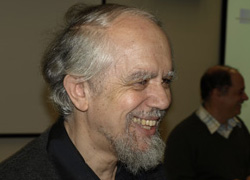IMDEA Networks

Archivos: Events
Virtual Reality and Haptics Applications in e-Learning, Industrial Training and Medical Education
Nicolas Georganas received the Dip. Ing. (Diplom-Ingenieur - German equivalent of M.Sc. degree) in Electrical Engineering from the National Technical University of Athens (Athens, Greece) in 1966. He went on to achieve his Ph.D. in Electrical Engineering (Summa cum Laude) in 1970 from the University of Ottawa (Ottawa, Canada). In 2004, he was conferred a Dr-Ing. (Doktor Ingenieur) (honoris causa) in Electrical Engineering by the Technische Universität Darmstadt (Darmstadt, Germany). In 2007, he was awarded his second Ph.D. (honoris causa) in Electrical and Computer Engineering by the National Technical University of Athens. He currently holds the position of Distinguished University Professor in the School of Information Technology and Engineering (SITE) of the University of Ottawa. In addition to this, he is also a Visiting Researcher at IMDEA Networks and a Cátedra de Excelencia at University Carlos III of Madrid (UC3M). In 1986 he became the Founding Dean of the University of Ottawa’s Faculty of Engineering, and from 2005-08 served as Associate Vice-President, Research (External).
Seguir leyendo arrow_right_altFlat Access and Mobility Architecture: an IPv6 Distributed Client Mobility Management solution
The use of centralized mobility management approaches – such as Mobile IPv6 – poses some difficulties to operators of current and future networks, due to the expected large number of mobile users and their exigent demands. All this has triggered the need for distributed mobility management alternatives, that alleviate operators’ concerns allowing for cheaper and more efficient network deployments.
Seguir leyendo arrow_right_alt
Modelling and Real-Trace-Based Evaluation of Static and Dynamic Coalescing for Energy Efficient Ethernet
The IEEE Standard 802.3az, namely Energy Efficient Ether- net (EEE), has been recently introduced to reduce the power consumed in LANs. Since then, researchers have proposed various traffic shaping techniques to leverage EEE in order to boost power saving. In particular, packet coalescing is a promising mechanism which can be used on top of EEE to tradeoff power saving and packet delay.
Seguir leyendo arrow_right_altAlgorithmic Mechanisms for Internet Supercomputing under Unreliable Communication
This work, using a game-theoretic approach, considers Internet-based computations, where a master processor assigns, over the Internet, a computational task to a set of untrusted worker processors, and collects their responses. The master must obtain the correct task result, while maximizing its benefit. Building on prior work, we consider a framework where altruistic, malicious, and rational workers co-exist. In addition, we consider the possibility that the communication between the master and the workers is not reliable, and that workers could be unavailable; assumptions that are very realistic for Internet-based master-worker computations.
Seguir leyendo arrow_right_altProtocol design issues in Underwater Acoustic Networks
Interest in underwater acoustic networking research has grown rapidly in the past few years. Fundamental differences between underwater acoustic propagation and terrestrial radio propagation call for new criteria for the design of communications systems and networking protocols. In this talk, we will provide an overview of the main challenges posed by the underwater acoustic propagation environment, with special emphasis on networking and protocol design issues, and provide novel insights that are useful in guiding both protocol design and network deployment. We will then address in more detail some specific examples of how the unique features of underwater propagation and acoustic modems affect protocol design. In particular, we will (1) focus on the energy consumption profile of acoustic modems and its impact on the design of topology control mechanisms and on the trade-off between sleep cycles and wake-up modes, and (2) present a novel energy-efficient routing protocol for underwater networks that explicitly accounts for the relationship between hop distance, bandwidth, and energy consumption.
Seguir leyendo arrow_right_altJornada de Encuentros Bilaterales Para la Transferencia de Tecnología en Servicios y Soluciones TIC, SIMO Network 2011
En el marco de SIMO network 2011, la Fundación madri+d para el Conocimiento organiza una jornada de carácter internacional dedicada a la transferencia de tecnología, donde se facilita el intercambio de información entre potenciales socios tecnológicos.
Seguir leyendo arrow_right_altOn the Compound Impact of Opportunistic Scheduling and D2D Communications in Cellular Networks
Opportunistic scheduling was initially proposed to exploit user channel diversity for network capacity enhancement. However, the achievable gain of opportunistic schedulers is generally restrained due to fairness considerations which impose a tradeoff between fairness and throughput. In this paper, we show via analysis and numerical simulations that opportunistic scheduling not only increases network throughput dramatically, but also increases energy efficiency and can be fair to the users when they cooperate, in particular by using D2D communications. We propose to leverage smartphone's dual-radio interface capabilities to form clusters among mobile users. We design simple, scalable and energy-efficient D2D-assisted opportunistic strategies, which would incentivize mobile users to form clusters. We use a coalitional game theory approach to analyze the cluster formation mechanism, and show that proportional fair-based intra-cluster payoff distribution brings significant incentive to all mobile users regardless of their channel quality.
Seguir leyendo arrow_right_altTREBOL: Tree-Based Routing and Address Autoconfiguration for Vehicle-to-Internet Communications; New Insights from the Analysis of Free Flow Vehicular Traffic in Highways
Efficient vehicle-to-Internet routing and address autoconfiguration are two of the missing pieces required to provide Internet connectivity from vehicles. Here, we propose TREBOL, a tree-based and configurable protocol which benefits from the inherent tree-shaped nature of vehicle to Internet traffic to reduce the signaling overhead while dealing efficiently with the vehicular dynamics.
Seguir leyendo arrow_right_altOptimization in optical networks
In the talk I overview some recent results for optimization problems that originate in optical networks. They deal with optimizing the utilization of regenerators (switching components that regenerate a signal after a certain distance) and ADMs (Add-Drop Multiplexers).
Seguir leyendo arrow_right_altFrom a national leadership to the World Championship. Lessons learned from Telefónica's internationalization process
This presentation intends to extract some useful hints on how to successfully manage an internationalisation process. It is focused on the specific case of a Spanish very large company: Telefónica, the leading Spanish telecommunications operator and one of the Top Ten telcos in the worldwide ranking by market cap nowadays.
Seguir leyendo arrow_right_alt











Comentarios recientes